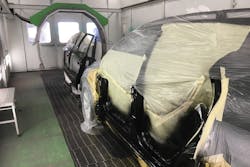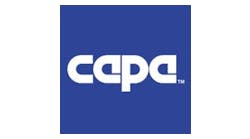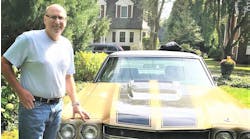Randy Sattler has no problem taking the occasional risk, provided his business might benefit from it.
That explains why Sattler, the manager at the Rydell Collision Center in Grand Forks, N.D., has used the innovative gas catalytic drying process at his shop since 2015. Gas catalytic drying is made possible through a chemical reaction created by turning methane gas into infrared energy that can quickly dry and cure paint, primer, and filler; Rydell currently uses three Greentech gas catalytic drying arch systems.
“I think we were the first in the United States to adopt the whole Body Shop Revolution repair process,” Sattler says. “We were the first ones, to the best of my knowledge, that went ‘all in.’”
While purchasing a gas catalytic arch involves a significant investment (such arches cost roughly $85,000 each, Sattler says) it can reduce drying time significantly. In fact, paint directly under a gas catalytic device can cure in less than 1 minute—speed that often leads to improved cycle time.
“Any time you have products that help minimize the amount of time that your technicians are waiting for stuff to dry” it helps, Sattler says.
Yet, when Rydell Collision Center first began using gas catalytic drying, the process resulted in a bit of an issue: it moved vehicles through the paint booth so quickly that it was tough for the shop staff to keep pace. Sattler soon discovered that solving this problem would require a group effort.
The Issue
A few years ago, Sattler noticed something perplexing about his body shop: while technicians were working on a lot of vehicles, repair work wasn’t getting completed all that quickly.
The 25,000-square-foot facility typically had ample work in process, yet it wasn’t translating to large profits.
“We, like lots of shops, would have tons of cars in WIP, not being worked on, just sitting there, which ties up a ton of cash,” Sattler recalls. “And it was very difficult to maintain any kind of workflow.
“All of a sudden it would come to Wednesday or Thursday, and what job has priority? ….. Well, this customer called and he’s screaming the loudest, so that’s the one we have to work on.”
When Rydell Collision Center began using the gas catalytic drying systems back in 2015, Sattler now acknowledges, the staff had no idea what the actual impact of the systems would be, or the extent to which they might alter the repair process. The body shop manager eventually concluded that he needed to tweak his facility’s staffing structure, adding a few employees in an effort to get vehicles rolling through his shop more smoothly.
“The gas catalytic systems, one of the most important factors that they brought to our attention was, you’re going to eliminate almost all of the drying time for your components,” Sattler explains. “So, you’re going to eliminate a ton of wait time.
“It really forced us to look at how we process the work with the repair side ... our vehicle damage assessment process of how we write an estimate. We forced ourselves to get better at estimating so we could get all of the damaged parts here prior to releasing the car to the floor.
“So, in developing the process, we’ve changed roles and added some people.”
The Answer
Sattler assessed where his body shop was and where he hoped to lead it. Then, he plotted a course to get there, by adding personnel in key areas.
He added a customer service representative at the front of his shop and decided to have three “vehicle damage assessment” employees in the back.
He devoted two employees to the task of doing pre- and post-repair diagnostic scans, and clearing codes. Additionally, Sattler decided to add the position of “insurance inspector,” an employee dedicated to the tasks of verifying and uploading files.
Rydell Collision Center began changing its staff structure in earnest in January 2018, and experienced employees helped provide on-the-job training to newcomers.
Sattler has found that seeking the input of veteran employees often pays dividends when making a business decision.
“That was one of the most valuable things that we learned,” he says, reflecting on recent months. “Upper management can have all types of great ideas, and say, ‘Hey, we’re going to try this,’ and two days later fail miserably at it, because we never asked for the opinion of anyone who’s going to be affected by that change.”
By seeking input from veteran employees, Sattler created the kind of goodwill that fosters a positive—and productive—work atmosphere.
The Outcome
Sattler has risked significantly altering his staff structure in the past, and the moves haven’t always worked. He broke up the admin structure one time, for example, and it led to occasional oversights by employees.
But, in 2018, Sattler appears to have gotten it right. This time, his revamped staff structure has resulted in a shop floor that works with precision, aided by those three gas catalytic drying arches.
“The gas catalytic products help us keep the [technicians] in their stall, working,” Sattler says. “Once the physical repair is done, to where you’re at the filler stage, then it just goes so much faster. It allows for much easier communication and the ability for us to focus on the priorities as the jobs roll through the shop.”
Sattler says his shop cut its WIP figure in half by February 2018; he now strives to have no more than 25 vehicles “in play” for his technicians at any point. Prior to utilizing gas catalytic drying the shop’s cycle time was above 7.5 days; that number was recently whittled down to 4.9 days.
And, the body shop has “grown the business a couple million dollars,” in recent months, Sattler notes. Rydell Collision Center now produces more than $7 million in annual revenue.
So far, this year has reminded Sattler that, when implementing a change in your business, it pays to consult with each employee that will be affected. That strategy has resulted in a 37-person staff that has bought in to his initiatives in Grand Forks.
And that, in recent months, has inspired Rydell Collision Center to keep increasing its staff.
“For us,” Sattler noted, “it comes down to asking, ‘OK, where are we at? Where do we want to be? How are we going to get there?’ And then, ‘Who’s going to be responsible to make sure we do the right things to get there?”



